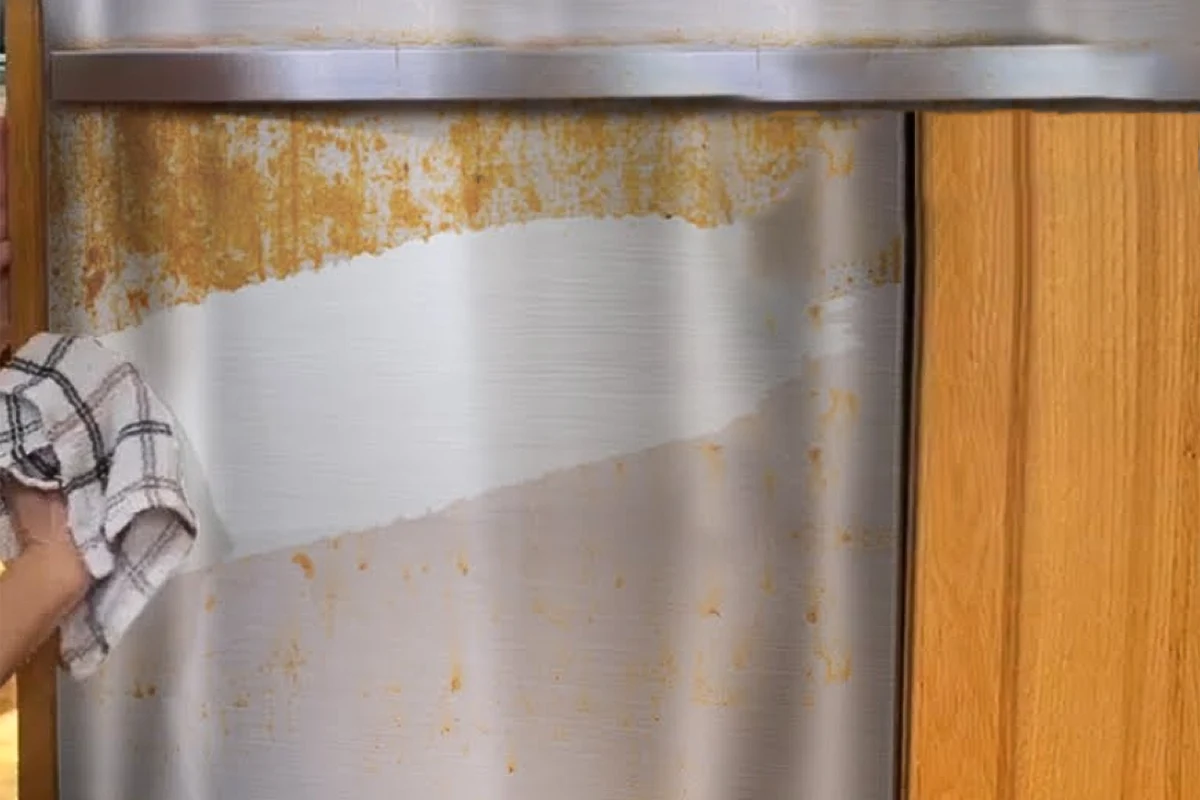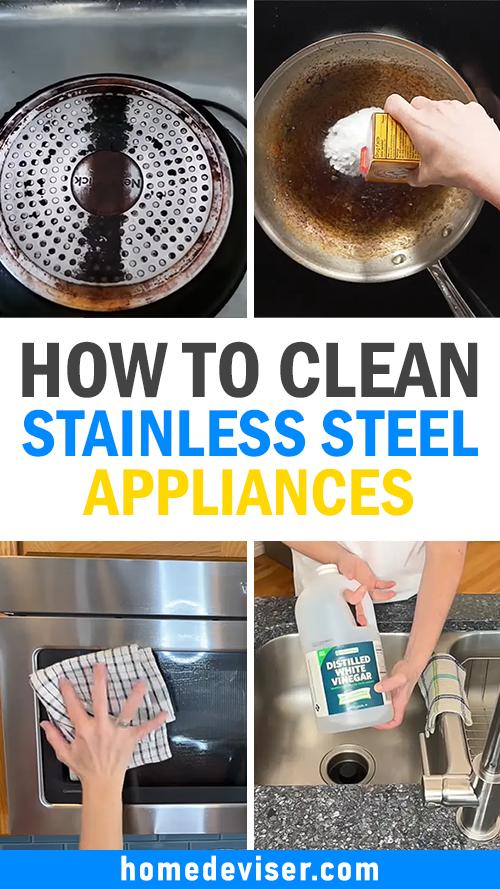
Stainless steel is found everywhere – from appliances in your kitchen to fixtures in your bathroom. You know it looks modern and sleek when cleaned properly. But have you noticed how it easily shows fingerprints, water spots, soap scum, and other grime? Don’t worry – I’m here to provide you with an essential guide to cleaning stainless steel so you can keep it looking its best!
Properly caring for stainless steel may seem tedious at times, but it’s worth the effort. Implementing a regular cleaning routine removes buildup that makes future cleanings harder. Using the right methods helps preserve the stainless steel’s finish and prevent corrosion. With just a little know-how, you’ll have stainless steel surfaces sparkling. Let’s get started!

Reasons to Keep Stainless Steel Clean
I know cleaning might not be your favorite task, but keeping stainless steel surfaces sparkling clean is worth the effort. Here are some key reasons you’ll want to get into a regular stainless steel cleaning routine:
Keeps stainless steel looking new and shiny
There’s just something about perfectly polished, gleaming stainless steel, isn’t there? That modern, sleek aesthetic is part of why you chose stainless steel appliances, sinks, and other items in the first place. But fingerprints, soap scum, and water spots make it lose that just-installed appearance fast. Staying on top of cleaning keeps your stainless steel-looking brand-spankin’ new.
Prevents the buildup of dirt, grease, fingerprints, water spots, etc.
When you let dirt, grease, soap scum, minerals, and food splatters sit on stainless steel too long, they start to build up. Before you know it, you’ve got layers of sticky, oily gunk adhered to there. Not cute. Getting into the habit of regular cleaning prevents gross buildup that makes the job so much harder.
Related: 13 Habits of People Who Always Have a Clean Home
Helps prevent corrosion and rust
All that buildup isn’t just an eyesore. When left for too long, it can actually break down the protective layer and lead to corrosion or rust. Yuck! We don’t want any of that icky orange spotted metal! Routine cleaning helps prevent accumulations that can compromise stainless steel.
It makes cleaning easier over time
Once grime has time to really adhere and cake onto stainless steel, it takes some serious scrubbing to get it off. But staying on top of cleaning means you can simply wipe away spills, fingerprints, and dust before they have a chance to stick. A little effort on the regular makes cleaning way simpler.
Prolongs life of stainless steel items
Since stainless steel has a softer finish than materials like porcelain, abrasive scrubbing can damage the surface over time. Cleaning often allows you to use gentle methods before grime gets caked on. This helps your stainless steel fixtures, appliances, and cookware maintain their finish longer.
What You Need
Getting your stainless steel surfaces sparkling clean requires just a few basic supplies you may already have at home. Here’s a quick list of must-have stainless steel cleaning tools and ingredients:
- Mild dish soap – Look for a formula labeled “gentle” that isn’t too harsh or abrasive. The dish soap helps cut through oil and grease.
- Soft cloths – Microfiber cloths work great, or you can use lint-free cloths or sponges. Avoid abrasive pads or paper towels that can scratch.
- Stainless steel cleaner or polish – These formulas are designed specifically for stainless steel and contain ingredients like mineral oil to polish away water spots and restore shine.
- Baby oil, olive oil, or mineral oil – The oils help break down fingerprints and smudges.
- White vinegar – Helpful for dissolving hard water deposits and stains. Avoid colored vinegar which could leave stains.
- Baking soda – Works as a gentle abrasive cleaner for stubborn stains and discoloration.
- Soft-bristle toothbrush – Useful for scrubbing baking soda paste on affected areas.
Keep these must-have stainless steel cleaning supplies on hand so you’re always prepared to clean and care for your stainless steel items.
Related: 13 Amazing Dawn Dish Soap Hacks
Cleaning Methods
Now let’s get into the nitty-gritty of how to clean stainless steel appliances using supplies you likely already have on hand:
For routine cleaning

Wash with mild soap and water
For day-to-day cleaning, washing with a few drops of gentle dish soap and warm water is perfect. The mild soap helps lift away greasy splatters and dirt without being too harsh on the stainless steel finish.
Rinse and dry thoroughly
It’s important to rinse very thoroughly after washing to remove any sudsy dish soap residue. Make sure to dry completely with a soft lint-free cloth too. This prevents unsightly spotting and streaks from water evaporating.
Apply stainless steel cleaner or polish
As a finishing touch for routine cleaning, apply a stainless steel spray cleaner or polish. Rub it in with a soft cloth according to the product directions. This helps maintain the protective layer and keeps that lustrous shine.
Related: 39 Homemade Natural Cleaners That Actually Work
For dirt and grease

Use degreasing dish soap and warm water
If you’ve got significant baked-on gunk and oily buildup, a degreasing dish soap helps cut through it. Let the soapy water sit for a few minutes before gently scrubbing. This gives it time to penetrate and loosen the greasy grime.
Rinse and dry thoroughly
Of course, you’ll want to rinse super well after using a stronger degreasing detergent. Make sure no soapy film remains. Carefully drying is also key to avoiding spotted mineral deposits in water.
For fingerprints and smudges

Rub a small amount of baby oil, olive oil, or mineral oil
Annoying fingerprints and smears on your stainless steel’s shiny surface can be easily banished with a little oil. Apply a small amount of baby oil, olive oil, or mineral oil directly onto the marks. Gently rub to break down and lift away fingerprints.
Rinse and dry thoroughly
You’ll want to thoroughly rinse and dry after using oil to remove fingerprints. Any oil residue left behind will just attract dirt. The rinse and dry ensures your stainless steel is left clean and streak-free.
For water spots and stains

Make a paste of equal parts white vinegar and baking soda
Hard water is a common culprit behind foggy spots and streaks on stainless steel fixtures. Make a cleaning paste by mixing equal parts white vinegar and baking soda. The vinegar helps dissolve mineral deposits while the baking soda gently scours.
Rub the paste on the affected area with a soft cloth
Use a soft cloth or sponge to rub the vinegar-baking soda paste onto water-spotted areas, going with the grain. Let it sit briefly to allow the fizzing paste to penetrate and break down the hardened water spots.
Rinse and dry thoroughly
You’ll want to rinse thoroughly after applying the paste to remove any vinegar or baking soda residue. Properly drying ensures you don’t get new water spots forming.
For stubborn stains/discoloration

Make a paste with baking soda and water
For stains that won’t budge with routine cleaning, make a paste with baking soda and water. The baking soda works as a gentle scouring agent to break down discoloration without scratching.
Use a soft-bristled toothbrush to scrub the paste on the affected area
Apply the baking soda paste to stained areas and let it sit briefly. Then use a soft bristle toothbrush to scrub and lift the stained spots away gently. The toothbrush gives added cleaning power.
Rinse and dry thoroughly
Be sure to rinse very well after scrubbing with baking soda paste. You want to remove any residue that could discolor the metal. Thorough drying also prevents new water spots from developing.
Professional Tips
- When possible, clean stainless steel in the direction of the grain. Rubbing in a circular motion across the grain can create tiny scratches.
- Don’t use bleach or abrasive cleaners like Comet or Ajax. The harsh chemicals can damage the protective layer. Stick to gentle dish soap, vinegar, baking soda, and stainless steel polishes.
- Make sure to rinse detergents thoroughly. Soap residues like chlorine can react with stainless steel and lead to corrosion over time.
- Immediately wipe up spills, especially acidic foods like tomato sauce or fruit juice. Acids can discolor or etch stainless steel if left to sit.
- Consider using distilled white vinegar for cleaning if you live in an area with hard water. Acetic acid helps dissolve mineral deposits.
- For food prep surfaces, sanitize with a 70% isopropyl alcohol solution after cleaning. This kills any remaining germs.
- Use a water filtration system if possible. Filtered water helps minimize mineral spots and stains from tap water.
- Don’t overlook the undersides of faucets and appliances. Grime likes to accumulate there too. Get into a habit of wiping those areas.
- Stainless steel pots and pans should be washed by hand. The dishwasher’s harsh detergents can cause pitting over time.
Related: 13 Natural Cleaning Ingredients
Final Thoughts on How to Clean Stainless Steel Appliances
Caring for your stainless steel items doesn’t require a ton of time or expensive cleaners. With just a little effort using mild dish soap, soft cloths, and natural ingredients like oil, vinegar, and baking soda, you can easily remove fingerprints, grease, hard water stains, and other grime.
Implementing a regular cleaning routine for stainless steel fixtures prevents future buildup that makes cleaning harder. Using the right gentle methods helps maintain the protective layer and keeps stainless steel looking pristine. Follow this essential guide and you’ll be a pro at cleaning stainless steel in no time!
